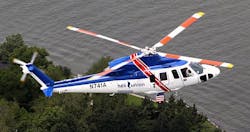Sikorsky chooses rotor blade de-icing avionics from Curtiss-Wright for S-76D medium-lift helicopter
CITY OF INDUSTRY, Calif., 19 July 2012.Helicopter designers at Sikorsky Aircraft Corp. in Stratford, Conn., needed ice-detection and -protection technology for the company's S-76D twin-engine medium-lift helicopter. They found their solution from the Curtiss-Wright Controls Avionics and Electronics segment in City of Industry, Calif.
Sikorsky awarded Curtiss-Wright a potential $12 million contract to supply Curtiss-Wright's ice detection and protection technology for the S-76D, which operators typically use for offshore oil, emergency medical services, executive transport, search & rescue, and airline applications.
Curtiss-Wright will provide Sikorsky with two separate helicopter avionics systems that work together to detect ice build-up and de-ice the helicopter's rotor blades as necessary.
The Curtiss-Wright Icing Severity Detection System (ISDS) will determine the rate of ice buildup on S-76D rotors. When required, the Rotor Ice Protection System (RIPS) activates the rotor blade heaters to de-ice the aircraft safely, Curtiss-Wright officials say. The initial value of the contract is $600,000. Sikorsky is a subsidiary of United Technologies Corp.
“Our advanced ice detection and blade de-icing systems enable the S-76D helicopter to fly in known icing conditions, significantly extending its utility and range,” says David Adams, co-chief operating officer of Curtiss-Wright Corp.
Curtiss-Wright engineers will build the ISDS equipment in Christchurch, England, and the RIPS equipment in City of Industry, Calif.
The S-76D helicopter can seat 12 to 13 passengers and has a gross-weight-lift capacity of 11,700 pounds. Powering the aircraft are two Turbomeca Arriel 2S2 turboshaft engines. The helicopter has a range of 411 nautical miles, can fly as fast as 155 knots, and can reach altitudes as high as 13,800 feet.
The S-76D cockpit avionics suite consists of the Thales TopDeck avionics system; four-axis fully coupled autopilot; enhanced ground proximity warning systems (EGPWS); traffic collision avoidance system (TCAS1); Honeywell Primus 660 weather radar; health usage monitoring system (HUMS); Thales digital map; and Rockwell Collins Pro Line 21 communications and navigation radios.
For more information contact Curtiss-Wright Controls Avionics and Electronics online at www.cwc-ae.com, or Sikorsky Aircraft at www.sikorsky.com.
Follow Avionics Intelligence news updates on Twitter, and join the revamped Avionics Intelligence group on Linkedin at www.linkedin.com/groups/Avionics-Intelligence.
About the Author
John Keller
Editor-in-Chief
John Keller is the Editor-in-Chief, Military & Aerospace Electronics Magazine--provides extensive coverage and analysis of enabling electronics and optoelectronic technologies in military, space and commercial aviation applications. John has been a member of the Military & Aerospace Electronics staff since 1989 and chief editor since 1995.
